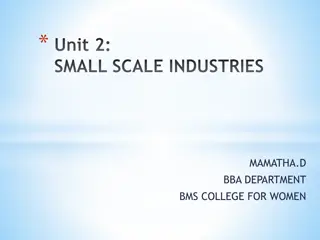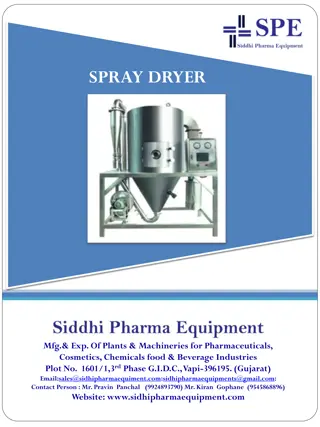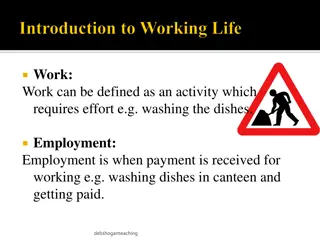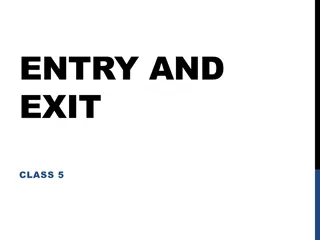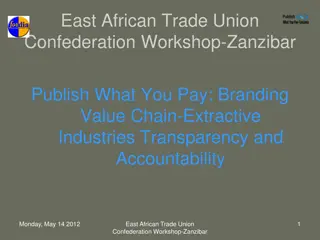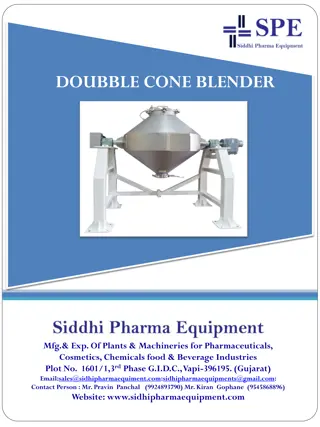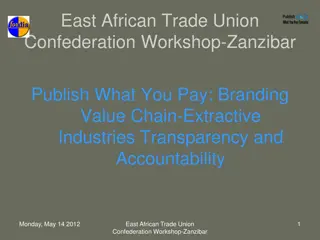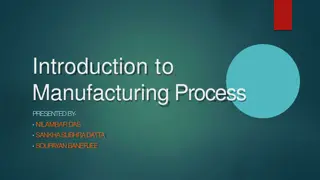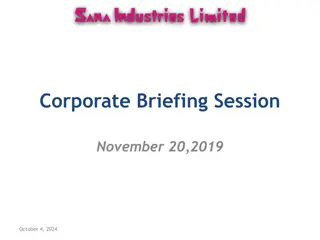Understanding Work Study in Various Industries
Work study is the analysis of how work is organized and the best methods to complete a job efficiently. It involves tasks such as method study, time measurement, and motion analysis. Industries like marketing, construction, and healthcare benefit from work study by improving productivity, reducing costs, and enhancing worker conditions.
Download Presentation

Please find below an Image/Link to download the presentation.
The content on the website is provided AS IS for your information and personal use only. It may not be sold, licensed, or shared on other websites without obtaining consent from the author. Download presentation by click this link. If you encounter any issues during the download, it is possible that the publisher has removed the file from their server.
E N D
Presentation Transcript
UNIT-2 WORK STUDY
WORK STUDY Work study is the study of how work is done. It looks at the way the work is organised. Method study aims at finding the best way of doing a job. This is done by eliminating unnecessary motions involved in a certain procedure or by changing sequence of operations or process itself. Once the motion study has developed an improved procedure for doing a job,the work measurement or time study will find the time allowed to complete the job by that procedure. Work measurement measures the time a worker takes to complete the job.
APPLICATIONS Industries Marketing,sales Offices,store Material handling Design Building and construction Transport Hospital Army agriculture
ADVANTAGES Improved production Reduced manufacturing cost Faster delivery Better employee-employer relation Better working and other conditions.
OBJECTIVES OF METHOD STUDY Improved working procedures Better working conditions Less fatigue to workers Better product quality Effective utilization of man,material,machinery Efficient and fast material handling Reduced health hazards.
METHOD STUDY PROCEDURE Select Record Examine Develop Install maintain
1.select The work is selected and its objective is defined. Objective may be reduction in manufacturing cost,increase in efficiency 2.Record Record all the relevant information pertaining to existing method in detail and in the form of chart. Recording can be done by: a) Process chart i) outline process chart ii) flow process chart iii)two handed process chart iv) multiple activity chart
b)Diagrams i) flow diagram Ii)string diagram Iii)cyclegraph Iv)Chronocyclegraph c) Motion and film analysis-simo chart d)Models
CYCLEGRAPH,CHRONOCYCLEGRAPH Cycle graph and Chrono cycle graph These are the techniques of analyzing the paths of motion made by an operator and were originally developed by the Gilbreths. To make a cycle graph , a small electric bulb is attached to the finger, hand, or any other part of the body whose motion is to be recorded. By using still photography, the path of light of bulb (in other words, that of the body member) as it moves through space for one complete cycle is photographed. The working area is kept relatively less illuminated while photograph is being taken. More than one camera may be used in different planes to get more details. After the film is developed, the resulting picture (cycle graph) shows a permanent record of the motion pattern employed in the form of a closed loop of white continuous line with the working area in the background. A cycle graph does not indicate the direction or speed of motion. It can be used for Improving the motion pattern, and Training purposes in that two cycle graphs may be shown with one indicating a better motion pattern than the other.
The chrono cycle graph is similar to the cycle graph, but the power supply to the bulb is interrupted regularly by using an electric circuit. The bulb is thus made to flash. The procedure for taking photograph remains the same. The resulting picture (chrono cycle graph), instead of showing continuous line of motion pattern, shows short dashes of line spaced in proportion to the speed of the body member photographed. Wide spacing would represent fast moves while close spacing would represent slow moves. The jumbling of dots at one point would indicate fumbling or hesitation of the body member. A chrono cycle graph can thus be used to study the motion pattern as well as to compute velocity, acceleration and retardation experienced by the body member at different locations. Figures show a cycle graph and a chrono cycle graph. The world of sports has extensively used this analysis tool, updated to video, for the purpose of training in the development of form and skill.
3.Examine Examine the recorded events critically and in sequence.critical examination involves answer to number of questions. Eg. What is done? who does it? Where,how,when 4.Develop Develop the best method as resulted from critical examination and record it. Developed method should be: Practical and feasible Safe and effective Economical Acceptable to all the dept
5) Install It involves three stages i.e planning,arranging and implementing. Implementation of developed method as standard practice. 6) Maintain Ensure proper functioning of installed method by periodic checks and verifications.
PROCESS CHART SYMBOLS Symbol event operation Storage(when an item is retained For some purpose Transport(movement of item from one location to another Inspection(correctness of quantity Or quality of items) D delay
PROCESS CHARTS A chart is a diagram or picture which gives an overall view of situation. A chart representing a process is called Process chart. A process chart helps in better understanding a process. Process charts are of three types: Outline process chart. Flow process chart Two handed process chart Multiple activity chart 1. 2. 3. 4.
1.OUTLINE PROCESS CHART An outline process chart is a process chart which gives an overall view of a process by recording only the main operations and sequences in proper sequence. such a chart requires only symbols for Operations and inspection . Outline process chart
2.Flow process chart It is detailed version of outline process chart,it records all the events. It is further classified as: Flow process chart(man) Flow process chart(equipment) Flow process chart(material) a) b) c)
Flow process chart(man) records activity of an operator. Flow process chart(equipment) records manner in which equipment is used. Flow process chart(material) records what happens to material.
TWO HANDED PROCESS CHART It is used only where hand movement is required i.e worker sitting at a place and performing work. It is used to record the activity of left hand related to right hand of operator and the activities are synchronized on a common time scale. All the 5 symbols are used in this chart.
4.MULTIPLE ACTIVITY CHART Multiple activity charts are the process charts using a time scale. It usually comes in picture when work study man wants to record the activities of one subject with respect to other on a single chart. Subject may be the worker, machine or equipment. 1. Man-Machine Activity Chart-when one operator is working on one machine. 2. Multi-man Activity Chart-when a group of workers are working on a machine. 3. Man- Multi machine activity chart- when a single operator is working on a number of machines. 4. Multi man- Machine chart- a group of operators working on a common central machine.
Travel chart consist of a square, which itself consists of a number of squares. Now, each small sequence represents a work station. A diagonal line is drawn from top left to bottom right. Say, a workplace or a workshop consists of 10 workstations and the movement of the worker is to be noted down. A big square in drawn and it is divided into 10 10 small squares. Each square represents a work station. Now, the movement of the worker from any station to other stations in shown in the travel chart. Movement of worker from station 1 to station 3 is shown in chart.
Critical examination of the above drawn travel chart shows that worker travels 5 times from stations 2 to station 6 Another busy route is from station 2 to station 4 as worker travels 3 times from station 2 to station 4. Thus 4-2- 6 is most busy route. So, it will be better to locate these stations next to each other. In this way, a new work layout can be produced, which will be economic in amount of distance travelled.
FLOW DIAGRAM It is a drawing or diagram which is drawn to scale.it gives complete picture of what is happening in plant. It shows relative position of production machinery,jigs,fixtures etc and marks the path followed by men,material and equipments. It is a scale plan or model of working area String diagram:when the paths are many and repetitive then flow diagram becomes congested and difficult to understand then string diagram is used. A string is used to locate the path.aim is to find path having minimum travel distance. Pins are used to locate units and string used to trace path
TOPICS Calculation of standard time by time study and work sampling performance rating factor types of rating job evaluation and performance appraisal,wage,incentive,bonus,wage payment plans.
SIMO CHART SIMO-Simultaneous motion cycle chart It is left and right operation chart. It shows on a common time scale simultaneous minute movements (therbligs) performed by the two hands of an operator. The time scale is represented in winks (1/2000) of a minute. This chart is usually used for micromotion study. Applications-component assembly,packaging,repetitive use of jigs and fixtures,inspection
TIME STUDY Measurement of time can be done by 1.Stop watch . There are three types a) Non flyback b) Flyback Split hand techniques. 2.Time study form 3.Steelrule or measuring tape 4.Tachometer 5.micrometer c)
Performance rating: It is used to convert observed time to normal time. A rating factor or levelling factor is a factor by which the observed time is multiplied in order to adjust for differences in operators performance. There are two types: 1)standard rating 2)normal rating. Standard rating is the rate at which the qualified worker will naturally work if he is motivated to apply himself to his work.. Normal rating-no motivation
WORK SAMPLING: Work sampling can tell what percentage of working day a person spends how i.e for how much time he works. Work sampling relies upon statistical theory of sampling and probability theory.. Normal frequency distribution and confidence level are associated very much with work sampling. Normal frequency distribution is graphical representation of occurrence of an event. A confidence level of 95.45% indicates that work study engineer is sure that 95.45% of the times,the random observation will represent true fact.
standard time is the time required by an average skilled operator, working at a normal pace, to perform a specified task using a prescribed method. Standard time =normal time +allowance Where; normal time =avg time *rating factor. (take rating factor between 1.1 and 1.2)
PRINCIPLES OF MOTION ECONOMY A. Use of Human Body: 1. The two hands should begin and complete their motion at the same time. 2. Arm movements should be symmetrical, simultaneous and in opposite directions. 3. Hand and body motions should be confined to lowest classification to perform the work satisfactorily. 4. The two hands should not be idle at the same time (except during rest). 5. Momentum should assist the worker (otherwise reduce to minimum). 6. Smooth continuous and curved movements preferable over straight-line movement with sharp changes in direction. 7. Ballistic movements are (easy fast and accurate) preferred over controlled movements. 8. Arrange work to provide natural rhythm where possible. 9. Eye fixations should be as few and as close together as possible.
B. ARRANGEMENT OF WORKPLACE: 1. Make definite and fixed place for all tools and materials. In other words there should be a place for everything and everything at its place. 2. Locate tools materials and controls as close to the place, of use as possible. 3. Gravity feed the material to the point of use (though bins and containers). 4. Locate materials and tools to permit best sequence of operations. 5. Good illumination for satisfactory visual perception. 6. Use drop delivery where possible. 7. Arrange work place height to permit alternate sitting and standing at work. 8. Provide chair of suitable type and height to permit good posture.
C. DESIGN OF TOOLS AND EQUIPMENT: 1. Relieve hands if the work can be economically done by jig, fixture or pedal. 2. Combine two or more tools where possible. 3. Pre-position tools/materials where possible. 4. When fingers are loaded divide work with according to the capabilities of the fingers. 5. Locate levers and handler to permit work with least change in body posture and greatest mechanical advantage.
WAGE INCENTIVES The purpose of incentive wage is to reward a more productive employee in proportion to his achievements. It motivates the worker to perform better and more. Incentives are given in addition to wages. Various commonly referred wage incentives are: Straight piece rate system. Halsey plan Gantt plan Emersons plan 100% bonus plan Bedaux plan Group plans 1. 2. 3. 4. 5. 6. 7.
TIME STUDY DATA Time study data is the outcome of work study. It contains information resulting from time study Operator performance units actually produced by worker/units of work which could be produced at std performance. Suppose there is 8hr duty and job should take 30mins to complete but after 8hrs an operator is able to complete only 14 such jobs,therefore operator performance is, 14 8?60/30?100 =14 16?100=87.5%
EXAMPLE-1 Given base wage rate: Rs 4/hr Bonus at std performance:33.33% Total items to complete:50 Processing time for each unit:3min Work completed in 140min To find bonus earned?
SOLUTION Earning rate of operator=base wage rate per hr+bonus wage rate. =4+33.33/100 x4=Rs 5.33 Earning rate per min=Rs 5.33/60=Rs 0.088 Operators actual earning= No of items to be made x time for one item x earning rate. =50x3x0.088 =Rs 13.32
Operators earning based on base wage rate =time taken to complete the work x base wage rate. =140/60 x 4 =Rs 9.33 Bonus earned by operator=13.32-9.33 =Rs 3.99 or 4








